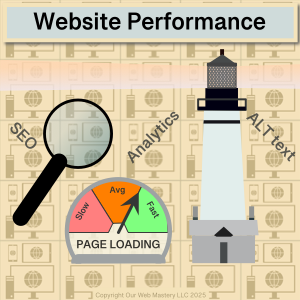Website Performance

Introduction – Why measure performance
As a website owner, your website’s content, look, and feel are your primary focus, but how do you check that your website works well? A website that responds slowly or isn’t great for people who use text-to-speech software to access websites can be a competitive disadvantage. The good news is there are many ways to asses and audit your website to get ideas for improvements.
Reading time: 2 minutes
Lighthouse
Overview
Lighthouse is an open-source, automated tool to help improve the quality of web pages. Give Lighthouse a URL, and it runs a series of audits against the page and then generates a report on how well the page performed.
What information can you get?
- Performance: Content display times, blocking time, layout shift, and a speed index.
- Accessibility: Names, labels, alt text, contrast, HTML elements, touch target size, and spacing.
- Best Practices: Trust and safety, image aspect ratios, legible font sizes, error and issue logs.
- SEO: Ensure that your page is following basic search engine optimization advice.
How to get started?
- Download Google Chrome Browser for Desktop (available for Windows, iOS, Linux, and most OSs).
- Open Chrome and browse to the URL you want to audit. You can audit any URL on the web.
- Open Chrome DevTools, click ⋮ -> More Tools -> Developer Tools
- Click the “Analyze page load” button.
Google Analytics
Overview
Google Analytics is a free web analytics service offered by Google that helps businesses understand how users interact with their websites and apps. It provides insights into website traffic, user behavior, and other vital metrics. You can use this data to analyze your website performance, optimize content, and improve your marketing strategies.
What information can you get?
- Active users: Over time, by country, by device type. New vs. returning users.
- Page views: By page statistics on views, active users, views per active user, and engagement times.
- Referrals: By first user source.
- Regional information: Users by country and by city.
How to get started?
- Create a Google Analytics Account.
- Create a Google Analytics Property.
- Add a data stream.
- Set up data collection.
See the following for more details on the steps to follow: https://support.google.com/analytics/answer/9304153.
References
- Web: https://developer.chrome.com/docs/lighthouse/overview
- Web: https://en.wikipedia.org/wiki/Lighthouse_(software)
- Web: https://www.google.com/analytics
- Web: https://en.wikipedia.org/wiki/Google_Analytics
Further Reading
See our article “Malware – Good practices for WordPress site owners” for more details on reducing the risk of attacks on your website.
See our article “Passwords – Good practices for WordPress site owners” for more details on securing your website.
See our article “Backups – Good practices for WordPress site owners” for more details.

